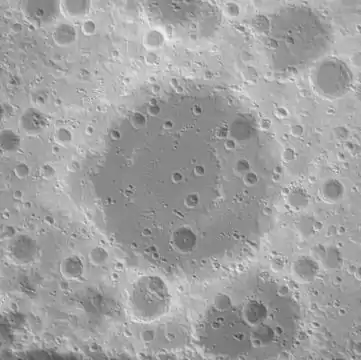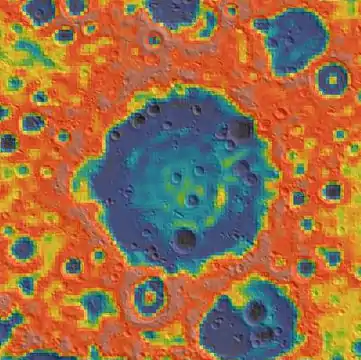Korolev (lunar crater)
Korolev is a large lunar impact crater of the walled plain or basin type. It is a basin of Nectarian age.[1]
 The crater Korolev (center) imaged by NASA's Lunar Orbiter 1 | |
| Coordinates | 4.0°S 157.4°W |
|---|---|
| Diameter | 437 km |
| Depth | Unknown |
| Colongitude | 163° at sunrise |
| Eponym | Sergei Korolev |
Korolev is named for Soviet rocket engineer Sergei Korolev. It lies on the far side of the Moon, and the northern part of its floor crosses the lunar equator. Notable nearby craters include Galois just to the southeast, Das to the south-southeast, Doppler attached to the southern rim, and Kibal'chich to the northeast. Rays of the crater Crookes (to the southwest) cover parts of the basin.
The outer rim of Korolev is heavily worn and eroded, with a multitude of small craters lying across the wide rim and the low inner wall. The interior floor is relatively flat compared to the surrounding terrain, but is pock-marked with many craters of varying sizes. The most notable of these interior craters are Korolev M in the southern part of the floor, and Korolev D next to the northeast rim.
Within the interior of Korolev is the remains of a second, inner ring. This is roughly half the diameter of the outer wall, and is the most intact in the eastern half. Here it forms a curving arc of ridges across the floor. At the midpoint of the formation, there is nothing resembling a central peak. However the craters Korolev B, Korolev T, and Korolev L lie within the diameter of the inner ring.
A small crater to the southwest of Korolev L was a designated control point, CP-1, during the Apollo 8 mission.[2] Measurements taken from orbit on this point improved the accuracy of mapping of the lunar far side, although they were likely surpassed by subsequent Apollo missions.
Until formal naming in 1970 by the IAU,[3] the crater was known as Basin XV.[4][5]
Korolev lies to the south of the similar-sized Dirichlet-Jackson Basin.
 Topographic map
Topographic map Gravity map based on GRAIL
Gravity map based on GRAIL
Views

Satellite craters
By convention these features are identified on lunar maps by placing the letter on the side of the crater midpoint that is closest to Korolev.
| Korolev | Coordinates | Diameter, km |
|---|---|---|
| B | 3.66°S 156.29°W | 21 |
| C | 0.73°S 153.22°W | 66 |
| D | 0.48°S 151.75°W | 24 |
| E | 3.43°S 153.38°W | 37 |
| F | 4.25°S 152.74°W | 30 |
| G | 5.67°S 153.46°W | 12 |
| L | 5.74°S 156.81°W | 31 |
| M | 8.50°S 157.37°W | 57 |
| P | 7.93°S 159.94°W | 18 |
| T | 4.14°S 157.84°W | 22 |
| V | 1.21°S 162.06°W | 19 |
| W | 0.18°S 160.53°W | 31 |
| X | 0.56°N 159.44°W | 27 |
| Y | 0.52°S 158.45°W | 19 |
| Z | 1.15°N 159.48°W | 18 |
See also
- 1855 Korolev, minor planet
- Korolev (Martian crater)
References
- The geologic history of the Moon. USGS Professional Paper 1348. By Don E. Wilhelms, John F. McCauley, and Newell J. Trask. U.S. Government Printing Office, Washington: 1987. Table 9-3.
- Analysis of Apollo 8 Photography and Visual Observations (NASA SP-201), compiled by NASA Manned Spacecraft Center, February 1969, pp. 59-61.
- Korolev, Gazetteer of Planetary Nomenclature, International Astronomical Union (IAU) Working Group for Planetary System Nomenclature (WGPSN)
- Lunar Farside Chart (LFC-1A)
- Lunar Landmark Locations - Apollo 8, 10, 11, and 12 Missions. NASA technical note D-6082. Manned Spacecraft Center, Houston, Texas. November 1970. Figure 2.
- Andersson, L. E.; Whitaker, E. A. (1982). NASA Catalogue of Lunar Nomenclature. NASA RP-1097.
- Blue, Jennifer (July 25, 2007). "Gazetteer of Planetary Nomenclature". USGS. Retrieved 2007-08-05.
- Bussey, B.; Spudis, P. (2004). The Clementine Atlas of the Moon. New York: Cambridge University Press. ISBN 978-0-521-81528-4.
- Cocks, Elijah E.; Cocks, Josiah C. (1995). Who's Who on the Moon: A Biographical Dictionary of Lunar Nomenclature. Tudor Publishers. ISBN 978-0-936389-27-1.
- McDowell, Jonathan (July 15, 2007). "Lunar Nomenclature". Jonathan's Space Report. Retrieved 2007-10-24.
- Menzel, D. H.; Minnaert, M.; Levin, B.; Dollfus, A.; Bell, B. (1971). "Report on Lunar Nomenclature by the Working Group of Commission 17 of the IAU". Space Science Reviews. 12 (2): 136–186. Bibcode:1971SSRv...12..136M. doi:10.1007/BF00171763. S2CID 122125855.
- Moore, Patrick (2001). On the Moon. Sterling Publishing Co. ISBN 978-0-304-35469-6.
- Price, Fred W. (1988). The Moon Observer's Handbook. Cambridge University Press. ISBN 978-0-521-33500-3.
- Whitaker, Ewen A. (1999). Mapping and Naming the Moon. Cambridge University Press. ISBN 978-0-521-62248-6.